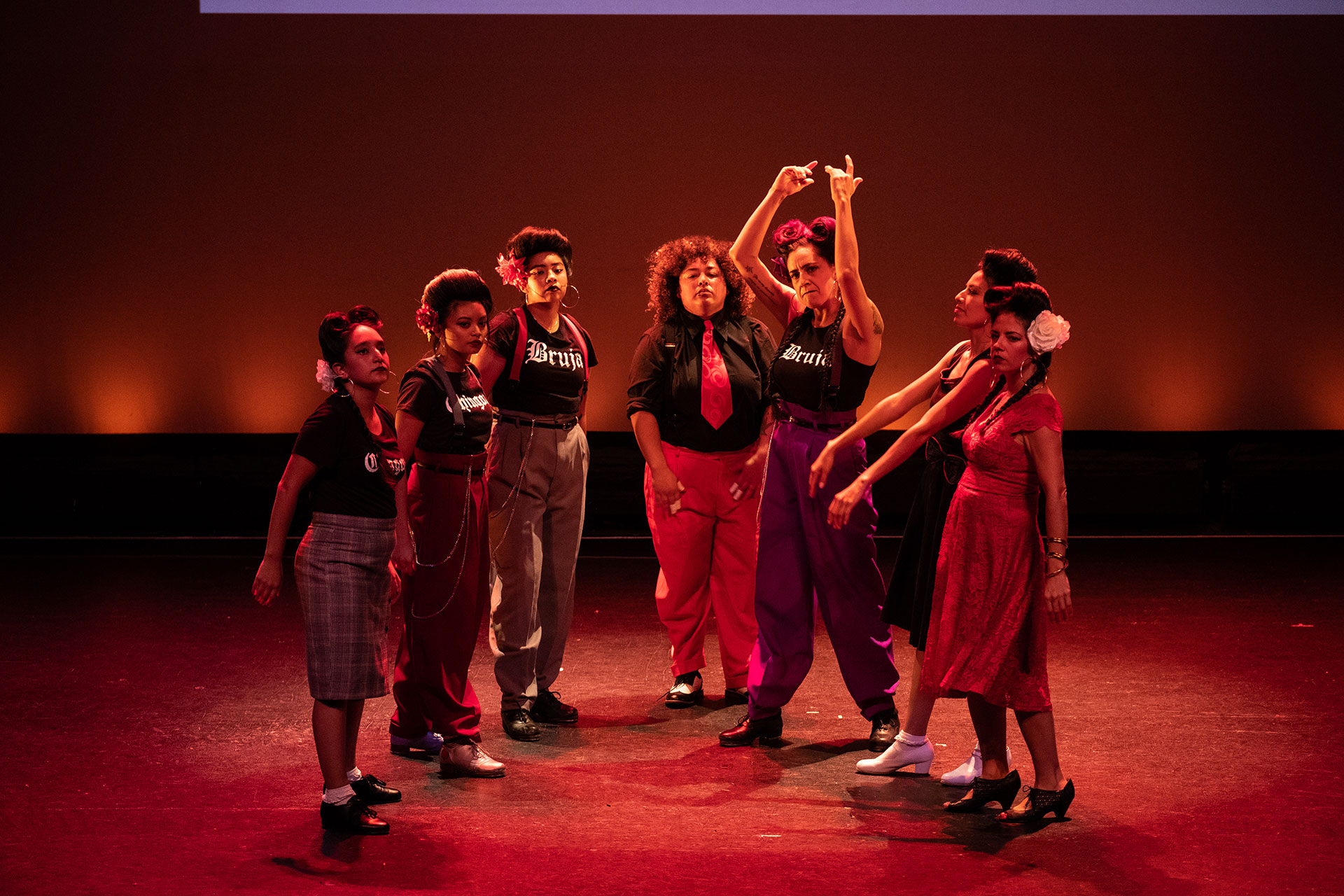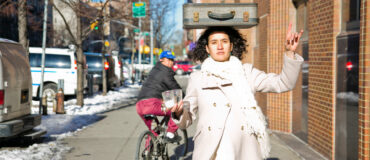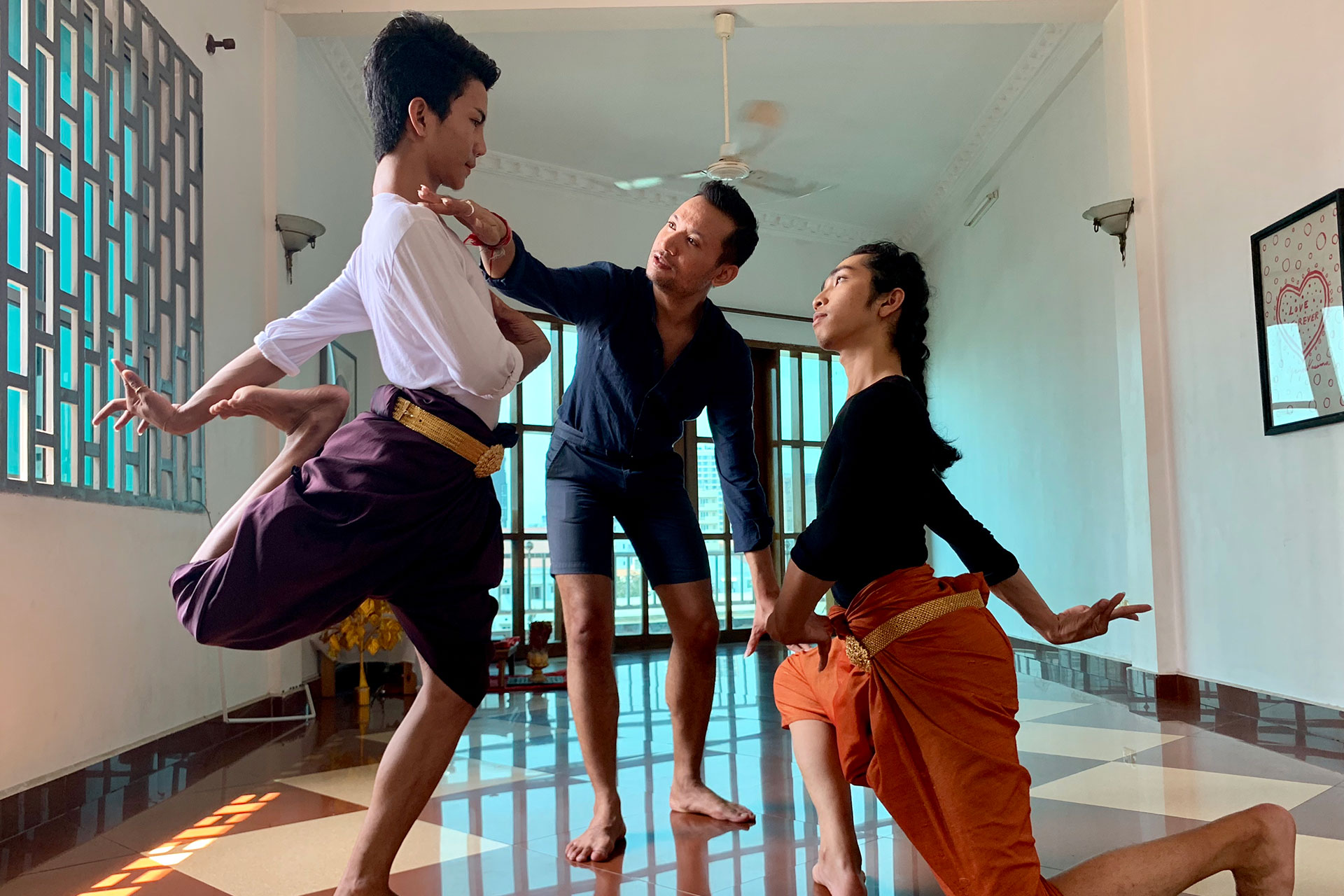‘All of Us Are Dancers:’ Creating Work With Non-Traditional Populations
Naomi Goldberg Haas, Allison Orr, and Pamela Quinn
By Sima Belmar
Editor’s note: This article is one of 11 in a series examining the creative work of 31 dance artists funded by Dance/USA Fellowship to Artists, generously supported by the Doris Duke Charitable Foundation. These artists’ practices are embedded in social change as they work in multiple dance forms in communities across the country.

“Revival: It’s About Time” brings together female choreographers in their 60s, 70s and 80s under Naomi Goldberg Haas’s direction, joined by 50 older adult community dancers. Danced in Claremont Park in Bronx, N.Y., in 2019, the piece celebrates power and transformation using flamenco vocabulary. Photo: Meg Goldman
- Nine dancers — middle-aged and beyond — dressed in black, some seated, some standing, perform a precisely timed exchange of multicolored balls and balloons to exuberant marching band music.
- On rain-slicked asphalt, in nighttime air lit by the headlights of sanitation vehicles, a lone crane operator spins his vehicle’s giant claw in choreographed patterns.
- Duets, trios, quartets, and quintets of dancers of all ages and ethnicities joyfully shimmy, slide, support, and swoop across Harlem housing project courtyards and community center gymnasiums, on basketball courts and on Old Broadway.
Exuberance. Energy. Joy. These qualities — along with pathos, precision, and purpose — are embodied in the choreographic works of Naomi Goldberg Haas, Allison Orr, and Pamela Quinn. Each of these artistic directors — of Dances for a Variable Population, Forklift Danceworks, and PD Movement Lab, respectively — sees dancers in every body and dances in every place. Goldberg Haas teaches at community centers and creates multigenerational, site-specific performances with professional and community dancers in New York City. Collaborating mostly with working class communities, Austin-based Orr has made dances with sanitation workers, urban forestry technicians, baseball players, gondoliers; in swimming pools, roller rinks, and campus kitchens. And Quinn, also in New York, teaches and makes dances for people with Parkinson’s disease, including folks who use walkers and wheelchairs in communities from Manhattan to Japan.
All three artists are trained dancers who have moved away from the conventional trappings of Western concert dance to explore and revel in the endless possibilities of human and non-human movement. They each challenge the arbitrary division between capital-D Dance and dance embedded in specific communities. They bring a dance mindset to bear on everyday activity and the everyday human body with its specialized knowledge culled from years of habituated movement as a result of work practices, disease, and aging. In so doing, the line between abstract postmodern dance and socially engaged creative practice blurs.

Allison Orr’s choreography begins with the movement of everyday work. From 2007-09, she collaborated with Austin’s Sanitation Department employees to create “The Trash Project.” With more than 2,000 people in attendance, the performance educated Austinites about the work of trash collection and gave employees like Ivory Jackson, Jr. (pictured here) a chance to showcase their expertise and talent.Photo: Amitava Sarkar
Orr acknowledges her contemporary/modern dance lineage. “I’m definitely Liz Lerman’s student. She was my mentor, along with Deborah Hay, so I consider myself a community-based artist. But I firmly hold onto the word ‘dance.’ I want to expand what people think of as dance and performance.” Orr finds bottomless capacity in defining her work as dance. “You can make great work with trash trucks and bucket trucks,” she explained. “The movement that inspires me is not typically happening in the dance studio. I am inspired by the movement of work and regular life, by the movement expertise people develop through a lifetime of embodied practice.”
Community-based work is often criticized for lacking rigor or for making aesthetic compromises that hurt the art. Quinn meets that challenge by balancing the artistic needs of the work, professional needs of the practice, and psychophysical needs of her dancers who have Parkinson’s disease. “I find a certain tension between what I’d like to see artistically and the experience I want my students to have,” Quinn said. “I’m making art. I’m not letting that go. I have certain standards that I want to meet. At the same time, I can’t make my students feel bad about not being able to do something. So, I’m constantly caught between figuring out what to ask them to do, seeing what they can do, and then adapting to what their capabilities are.”
RIGOR, PRACTICE, LEARNING, and LISTENING

Pamela Quinn’s “Ooh Aah!” was facilitated by Dance for PD and commissioned by the Unity Walk, an educational event in Central Park about Parkinson’s disease attended by thousands. The seated dancers, participants in her PD Movement Lab, are both people with and without Parkinson’s. Photo: Colin O’Connor
While all three artists adjust their aesthetic choices to benefit and be accountable to everyone involved, they also hold their collaborators to the professional standards of dance practice. Quinn said: “I rehearse them like they’re professionals. I have expectations of them. Having them learn what it means to make a dance — the commitment required for rehearsal, understanding that making something is not necessarily a smooth, sequential process, appreciating the interdependence of the dancers — all these things are part of understanding the creative process.” For Goldberg Haas’s students, having to rehearse feels foreign, “but when they practice repeating material, they understand the value.”
Orr develops best practices in response to particular goals and needs of the people involved in a given project: “In the process of creating our dances, we continually check in with our collaborators to confirm that we are meeting their needs because we are most accountable to them. The idea that community work is somehow dumbed down or easier simply isn’t true. We hold our performances to a high aesthetic standard.”
While Forklift collaborates with people and organizations that have no dance background, she emphasized that the process is full of rigor, practice, learning, and listening. “It’s not easy and it’s not cheap,” Orr said. “It’s expensive because you are investing in a relationship for a long, long time.” It takes an average of three years for a project to come to fruition, a long-term commitment that amplifies the voices of community collaborators.

Orr’s inclusive choreographic projects include 2018’s Dove Springs Swims, which used a public pool as a stage and a cast of neighborhood residents, lifeguards, aquatic maintenance staff, and the local swim team to tell the story of a neighborhood pool and the community that fought to create it. Photo: Jonica Moore
For Goldberg Haas, dance is a vehicle of creative expression and wellness, one that everyone should have access to: “We are dedicated to serving our communities to make sure they have the social, the health, the physical experience of what it means to be a dancer. We all share the impulse to celebrate the individual. We have to listen and look really hard to see where they shine. It’s a big job.”
All three artists are white women who work with diverse populations, and who grapple with potential exploitation and cultural appropriation. For Quinn, having Parkinson’s disease herself affords her some immunity, giving her “certain license to push my students, to challenge them.” Nevertheless, she recounts a story of unintentional exploitation when a photographer took pictures of her class. “I wanted to use an image of a woman …. Through her curved body you see the other participants,” Quinn said. “A compositional thing happened because of her posture.” Later, the woman declined having her photo taken again. Quinn wondered if it was related to the other picture. “I felt horrible that she may have felt used or badly about herself in that photograph. That was a moment of unintentional exploitation for an aesthetic reason on my part.”
Orr’s community collaborators always get paid, either by the institution that agrees to have Forklift job-shadow its employees or by Forklift directly. Everyone gets to choose whether or not they participate. Still, Forklift hears some skepticism from outsiders. Once, a Wesleyan College student asked Orr what gives her the right as a white woman with privilege to go into working class communities, often communities of color. “Ultimately this question gets answered through the process of making the work together — a process in which trusting relationships are built and our collaborators have agency to tell their stories in ways that are authentic to them. We look to our collaborators to hold us accountable. Are we meeting the needs that they would like the project to address? It’s a reciprocal relationship: We’re getting expertise and a capacity to make work that we wouldn’t be able to get any other way, and we’re offering an opportunity to participate in an art-making process that wouldn’t happen without our presence.”
Whiteness has long been associated with claiming a right where there is none. It seems to me that Goldberg Haas, Quinn and Orr don’t simply have the right to do their work, they earn it with each project, in each community they work with, over and over again.
DANCE AS A SOCIAL ACT, AT A DISTANCE
I was invited to talk with these artists before the United States was plunged into lockdown by the novel coronavirus and protestors took to the streets across the country demanding an end to white supremacist practices in the wake of the murder of George Floyd. Since that time, dance, which is always a social act, whether or not the practitioner is explicitly concerned with social themes, has been called to reinvent itself in the context of social distancing.

Goldberg Haas’s “Fanfare” was created with Dances for a Variable Population dancer Betty Williams, whose Parkinson’s affects her mobility. In rehearsal, Williams got atop a box in precarious positions, fearless. Haas wondered, “How long could we keep her in the air?” She is supported by Maggie Gavin and Kaitlin Morse. Photo: Meg Goldman
But for the older adult communities Goldberg Haas serves, the pandemic has illuminated inequities in the dance field — and the world at large. “Many of the communities we work with don’t have online access or computers,” she said. “But many people do have telephones, so we’ve set up telephone conference calls. We have artists teaching classes to 40 people over the telephone. We’ve had to move our big annual show online. But knowing there’s such limited online access, we’ve tried to get some local broadcasting because they do have TVs.”
Goldberg Haas created a series of park bench videos, inspired by the ways runners use benches to stretch their legs and back. Rather than fabricating complicated choreography, she uses the park bench for dancers to reframe the stretch as something artful. The chance to pay attention to what it means to curve and arch, reach and relax, to just bear witness to someone’s wingspan, to feel that open chest can be breathtaking.
Since Forklift’s work is often rooted in public gatherings, Orr and her collaborators have had to find novel ways to see projects through. “We’re doing a performance project via the radio. Austin’s Black community radio station is our host,” Orr said. “It was a year-long project about the community and history around Downs Field, home to Negro League baseball in central Texas.” Now instead of gathering on the baseball field, audiences will tune in to KAZI 88.7 FM as dance takes to the airwaves.

Quinn’s 2019 “Give and Take,” performed as part of a Dance for PD program, explored the physical and emotional progression of those with Parkinson’s disease. “I rehearse my students like they’re professionals,” she says. She wants them to understand what it means to make — and perform — a dance: “I have expectations, and they respond.” Photo: Nan Melville
For Quinn, the pandemic has set into relief the social aspect of her work. “You know how if you break your pinky you suddenly realize how much you use it?” Quinn said. “That’s how I feel about the role of social interaction in our work. It’s a difficult transition to make right now.”
Exuberance. Energy. Joy. Each of these expressions bubbles over in the works of these artists. Orr says she and her collaborators deliberately choose to go to joy. “Particularly with city employees, the working-class staff of certain institutions, and the neighborhoods we’ve partnered with over the past few years, the picture is, yes, life is hard and people are living under very challenging circumstances. But we want to offer an opportunity for people to talk about what they love. It’s not usually what they’re asked to pay attention to or to share.” Orr’s interview process when she’s invited into a workplace to construct a dance event includes standard questions: “What do you love about your job? What’s hard? What do you want people to know about you and your fellow workers?” Orr said, “There is a real power in letting people talk about what they love.”
Goldberg Haas begins by asking her students what makes them happy. “I tell them not to think about the past,” she said. “We talk about what their state is right now and how they can go forward.” Quinn takes a similar approach. She doesn’t start with a particular question but rather invites her students to recognize their disabilities as enhancements to the work. “These people are up there performing, exposing their bodies, which they may try to hide in certain ways,” she said. “They’re doing something vibrant together.”
Goldberg Haas, Orr, and Quinn have worked to provide continuity during this period of physical distancing with the same ingenuity and compassion that imbued their pre-pandemic work. The three find exuberance, energy, and joy by listening deeply to their own bodies and to the needs and desires of their constituents. In the words of Goldberg Haas: “All of us are dancers.”
Quinn’s
2019 “Give and Take,” performed as part of a Dance for PD program, explored the physical and emotional progression of those with Parkinson’s disease. “I rehearse my students like they’re professionals,” she says. She wants them to understand what it means to make — and perform — a dance: “I have expectations, and they respond.” Photo: Nan Melville

Sima Belmar, Ph.D., is a lecturer in the Department of Theater, Dance, & Performance Studies at the University of California, Berkeley, and the ODC writer in residence. She writes the monthly “In Practice” column for In Dance, a publication of Dancers’ Group. Her writing has appeared in popular and scholarly publications such as Dance Magazine, San Francisco Bay Guardian, The Oakland Tribune, The Brookyn Rail, The Oxford Handbook of Screendance Studies, TDR, Performance Matters, Journal of Dance & Somatic Practices, L’avventura: International Journal of Italian Film & Media Landscapes, and Contemporary Theatre Review. To keep up with Sima’s writing please subscribe to tinyletter.com/simabelmar.
Please visit the artists’ websites: Naomi Goldberg Haas, Allison Orr, and Pamela Quinn. Readers may read and print a PDF version of this article here. Readers may visit and share this article on Medium here. Find more information on the DFA Article Series here and more information on Dance/USA Fellowships to artists here.
____
We accept submissions on topics relevant to the field: advocacy, artistic issues, arts policy, community building, development, employment, engagement, touring, and other topics that deal with the business of dance. We cannot publish criticism, single-company season announcements, and single-company or single artist profiles. Additionally, we welcome feedback on articles. If you have a topic that you would like to see addressed or feedback, please contact communications@danceusa.org.
Disclaimer: Opinions expressed in guest posts do not necessarily represent the viewpoints of Dance/USA.




